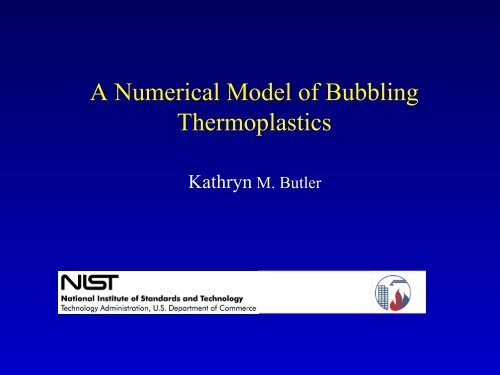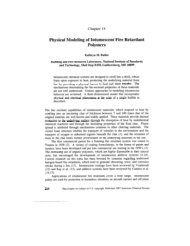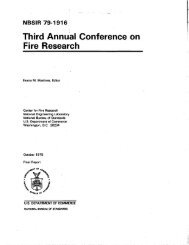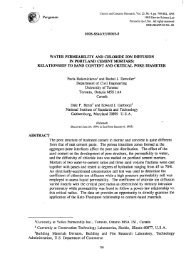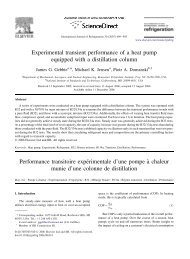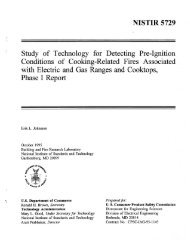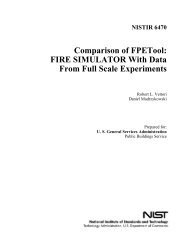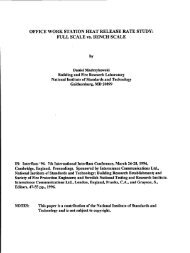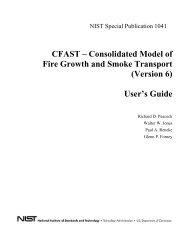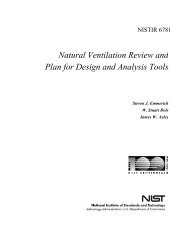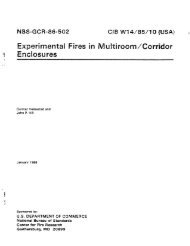A Numerical Model of Bubbling Thermoplastics
A Numerical Model of Bubbling Thermoplastics
A Numerical Model of Bubbling Thermoplastics
Create successful ePaper yourself
Turn your PDF publications into a flip-book with our unique Google optimized e-Paper software.
A <strong>Numerical</strong> <strong>Model</strong> <strong>of</strong> <strong>Bubbling</strong><br />
<strong>Thermoplastics</strong><br />
Kathryn M. Butler
Thermoplastic Materials in Fire
Microscopic Photographs <strong>of</strong> PMMA<br />
Kashiwagi and Ohlemiller, 19 th Intl. Symp. on Comb., pp. 815-823 (1982)
• 1-D Finite element model<br />
<strong>Numerical</strong> <strong>Model</strong><br />
– Mass balance for gas and polymer<br />
– Energy balance<br />
• Individual bubble dynamics<br />
– In 3-D<br />
– Sizes and locations <strong>of</strong> bubbles<br />
determine amount <strong>of</strong> gas in each<br />
element<br />
– Motion <strong>of</strong> bubbles determine velocities
• Polymer<br />
∂<br />
∂t<br />
•Gas<br />
∂<br />
∂t<br />
Continuity Equations<br />
( ) ( ) −E<br />
/ RT<br />
ρ φ + ρ φ W = −ρ<br />
φ Be<br />
p<br />
p<br />
∂<br />
∂z<br />
p<br />
p<br />
( ) ( ) −E<br />
/ RT<br />
ρ φ + ρ φ W = + ρ φ Be<br />
g<br />
g<br />
∂<br />
∂z<br />
• Volume Fractions:<br />
g<br />
g<br />
p<br />
g<br />
φ p =<br />
Vp V<br />
p<br />
p<br />
p<br />
p<br />
φg<br />
=<br />
Vg V
Energy Equation<br />
RT<br />
E<br />
p<br />
p<br />
v<br />
p<br />
Be<br />
H<br />
z<br />
T<br />
k<br />
z<br />
z<br />
T<br />
W<br />
t<br />
T<br />
c<br />
/<br />
*<br />
*<br />
*<br />
)<br />
(<br />
−<br />
−<br />
⎟<br />
⎠<br />
⎞<br />
⎜<br />
⎝<br />
⎛<br />
∂<br />
∂<br />
∂<br />
∂<br />
=<br />
⎟<br />
⎠<br />
⎞<br />
⎜<br />
⎝<br />
⎛<br />
∂<br />
∂<br />
+<br />
∂<br />
∂<br />
φ<br />
ρ<br />
ρ<br />
k<br />
p<br />
k<br />
k<br />
k<br />
p<br />
c<br />
c ∑<br />
= φ<br />
ρ<br />
ρ<br />
*<br />
)<br />
(<br />
where<br />
∑<br />
∑<br />
=<br />
k<br />
k<br />
k<br />
k<br />
k W<br />
W<br />
φ<br />
ρ<br />
φ<br />
ρ<br />
*<br />
g<br />
p<br />
g<br />
p<br />
k<br />
k<br />
k<br />
φ<br />
φ<br />
)<br />
(<br />
)<br />
(<br />
* =
• Nucleation<br />
• Bubble growth<br />
• Migration<br />
• Coalescence<br />
• Bursting<br />
Bubble <strong>Model</strong>
Bubble Nucleation<br />
• Homogeneous vs. heterogeneous nucleation<br />
(Thermal fluctuations) (Impurities)<br />
• Arrhenius function for nucleation rate J<br />
= MB exp( − ∆F<br />
k T )<br />
• Elasticity<br />
J cr / B<br />
• Gas diffusivity through melt<br />
• Rate easily varies by 9+ orders <strong>of</strong> magnitude!
Secondary Nucleation<br />
1 m<br />
5 m<br />
Yarin et al., AIChE J. 45:2590-2605 (1999)
Bubble Growth<br />
• <strong>Model</strong>s<br />
– Infinite domain; finite radius<br />
– Temperature gradients – radial<br />
– Dominant mechanism depends on size<br />
• Surface tension, inertia, evaporation<br />
1/<br />
2<br />
R ∝<br />
t<br />
– Diffusion-driven:<br />
– Polymer melt: between Newtonian fluid and diffusiondriven<br />
growth<br />
• Secondary nucleation<br />
– In strongly viscoelastic liquids
Bubble Migration<br />
• Driven by gravity, temperature gradients<br />
(surface tension, viscosity dependence on T)<br />
U<br />
=<br />
−<br />
2<br />
2(<br />
ρ p − ρ g ) gR ⎡ ⎛ d ln µ ⎞ R ⎛ d lnσ<br />
⎞⎤<br />
∂T<br />
+ ⎢2RR&<br />
⎜−<br />
⎟ + ⎜−<br />
⎟<br />
9µ<br />
dT<br />
dT<br />
⎥<br />
⎣ ⎝ ⎠ 3µ<br />
⎝ ⎠⎦<br />
∂z<br />
• Wake effects<br />
• Bubbles slow as approach surface
Approach to Interface<br />
Chi and Leal, J. Fluid Mech. 201:123-146 (1989)
Bubble Velocity Nearing Interface<br />
Bubble Velocity<br />
Distance from interface<br />
Chi and Leal, J. Fluid Mech. 201:123-146 (1989)<br />
d
• Stages:<br />
Coalescence and Bursting<br />
– Approach<br />
– Drainage <strong>of</strong> thin film<br />
– Rupture by surface instability - rapid<br />
• Strongly dependent on presence <strong>of</strong> surfactants<br />
– Clean interface: ~ 1 ms<br />
– Surfactant: ~100 s<br />
• Vaporization due to heating not considered
Thin-film Drainage
Bursting<br />
• Gases released by sample<br />
– Determines the mass loss rate<br />
– Heat release rate <strong>of</strong> fire<br />
• Long-lasting bubbles may form insulating<br />
layer
Bubble <strong>Model</strong><br />
R &<br />
∆poly<br />
→ ∆gas<br />
elem<br />
elem<br />
U<br />
∆tdrain<br />
.<br />
∆gas<br />
← ∆poly<br />
elem<br />
m&<br />
elem<br />
TN<br />
Ti<br />
+ 1<br />
Ti<br />
Ti<br />
−1
<strong>Numerical</strong> <strong>Model</strong>
Effects <strong>of</strong> Bursting Delay in PP<br />
Drainage time = 0 sec<br />
0.01 sec
Effect <strong>of</strong> Bursting Delay on<br />
Sample Thickness vs. Time<br />
0 s<br />
0.01 s<br />
Drainage times = 0, 0.01 seconds
Temperature vs Time for<br />
Sample Surfaces<br />
Drainage times = 0 (orange), 0.01 (green) seconds
Nucleation <strong>Model</strong>
PP vs. PMMA
• Radiation<br />
Other Bubble Effects<br />
– Internal transmission<br />
– Scattering<br />
• Oxygen entrainment<br />
• Distortion <strong>of</strong> surface geometry
Conclusions<br />
• <strong>Bubbling</strong> behavior in thermoplastic materials<br />
exposed to fire is highly complex<br />
– First principle modeling has a long way to go<br />
• Because <strong>of</strong> insulating layer and direct impact on<br />
mass loss rate, bubble behavior at surface is critical<br />
– Bursting, coalescence, nucleation, approach to interface<br />
– Need to include radiation effects


